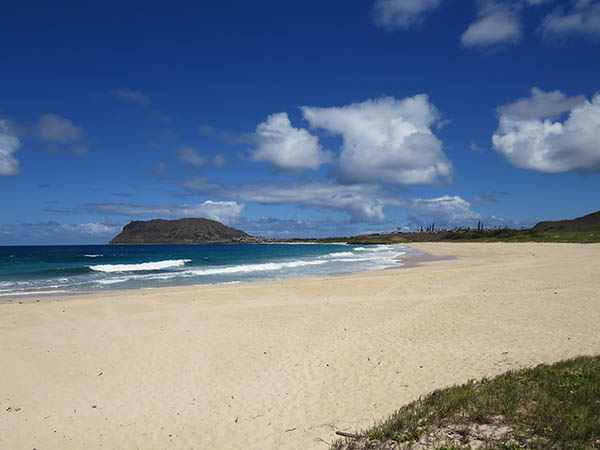 |
 |
 |
|||||
|
Obake Story:
“Mā‘elieli is the name of that hill,” Kalani says. “It’s a pu‘u [hill], about seven hundred, eight hundred feet high, inland of Ke‘alohi point in He‘eia. And Mā‘eli‘eli was the mo‘o with a surfboard tongue. It was pointed out that her residence was there in He‘eia. That stream that comes down that empties right by the fish pond, It was a stream.That was where she would come out and descend into the bay and swim over to Mōkapu. And how do we know about her? An interesting story that was recorded by Glen Grant. “A Japanese picture bride was brought out to Hawai‘i and she and her husband and other men-friends were all workers over at Wai‘alua plantation. And they would go out fishing on weekends. This is in the late thirties maybe, before all the activity of the War years and the expansion of the Mōkapu runway. So one weekend, her husband and his friends went out camping at Heleloa beach on the Mōkapu penninsula. She was the only female with him, and she was left to tend to the camp, tend the fire and what not by herself. And as she told the story, she looked up from what she was doing and saw a tall Hawaiian man dressed in a feather cloak and helmet, coming down the beach. “Kind of an odd thing to be happening, but anyway, she had been told, ‘You should be friendly to all strangers.’ So she got up to go greet him, and she was saying ‘Aroha, Aroha.’ He paid no attention, just kept going straight ahead. She tried again to be friendly—‘Aroha! Aroha!’ Well, he suddenly turned and stared at her as though to say ‘Get out of here!’ Oh! she was frightened, of course, and she startled back. But as he moved on, she looked down and saw that he had no feet! He was floating! So very afraid now, she called and called to her husband the other men, saying ‘Obake! Obake!’—ghost in Japanese. They all came back and she told them what had happened, and so they all decided, ‘We better get out of here, this place has ghosts!’ “Well there was one fisherman missing and they recalled he went way down the beach. So they went to go look for him. And there he was, flattened out on the beach on his back with all this green slime all over him. They roused him and said, ‘What happened? What happened?’ He said, ‘Well, I heard all the commotion down the beach, so I started to pull in my nets. I pulled and I felt something very heavy and I thought I must have gotten lot of fish! But out of the nets came this woman, nude!’ She came up to him and she jumped on his back and slapped him and made him carry her. With all of this, he just passed out, and he fell down and next thing he knew, she was on top of him and out came this surfboard tongue. And she was lapping him, licking him, and all of this green slime came out that covered him. So that was his meeting with Mā‘eli‘eli. And that’s within recent times. It’s a true story. Who would doubt this Japanese war bride, why would she make up the story? That’s a story I tell in class as, 'What does that mean?' “As far as the authenticity of the tradition, I can’t say,” Ian says. “It’s a modern story, but it’s very compelling and it goes back to that surfboard-shaped tongue which was either the tongue or the tail, like Kiha-wahine, the mo‘o's tail was the surfboard, and all that stuff. Another tale in Kipahulu tells of a man getting lost in a m‘oo cave and coming out weeks later with his body covered in slime and scales—and he was never the same after that." |
|
|||||
|
Pacific Worlds > He‘eia, O‘ahu > Footprints > Mā‘eli‘eli & Mo‘o |
||||

